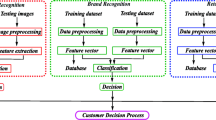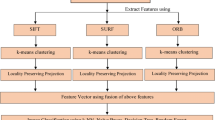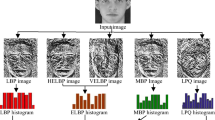Abstract
Local feature descriptor has been widely used in computer vision field due to their excellent discriminative power and strong robustness. However, the forms of such local descriptors are predefined in the hand-crafted way, which requires strong domain knowledge to design them. In this paper, we propose a simple and efficient Spherical Hashing based Binary Codes (SHBC) feature learning method to learn a discriminative and robust binary face descriptor in the data-driven way. Firstly, we extract patch-wise pixel difference vectors (PDVs) by computing the difference between center patch and its neighboring patches. Then, inspired by the fact that hypersphere provide much stronger power in defining a tighter closed region in the original data space than hyperplane, we learn a hypersphere-based hashing function to map these PDVs into low-dimensional binary codes by an efficient iterative optimization process, which achieves both balanced bits partitioning of data points and independence between hashing functions. In order to better capture the semantic information of the dataset, our SHBC also can be used with supervised data embedding method, such as Canonical Correlation Analysis (CCA), namely Supervised-SHBC (S-SHBC). Lastly, we cluster and pool these learned binary codes into a histogram-based feature that describes the co-occurrence of binary codes. And we consider the histogram-based feature as our final feature representation for each face image. We investigate the performance of our SHBC and S-SHBC on FERET, CAS-PEAL-R1, LFW and PaSC databases. Extensive experimental results demonstrate that our SHBC descriptor outperforms other state-of-the-art face descriptors.














Similar content being viewed by others
Notes
The results of other methods in this figure are cited from http://vis-www.cs.umass.edu/lfw/results.html
The eye coordinates of each face image can be found at http://www.cs.colostate.edu/~vision/pasc/index.php
References
Ahonen T, Hadid A, Pietikainen M (2006) Face description with local binary patterns: application to face recognition. IEEE Trans Pattern Anal Mach Intell 28 (12):2037–2041. doi:10.1109/TPAMI.2006.244
Andoni A, Indyk P (2006) Near-optimal hashing algorithms for approximate nearest neighbor in high dimensions. In: 47th Annual IEEE symposium on foundations of computer science, 2006. FOCS’06. IEEE, pp 459–468
Andoni A, Indyk P (2008) Near-optimal hashing algorithms for approximate nearest neighbor in high dimensions. Commun ACM 51(1):117–122. doi:10.1145/1327452.1327494
Arashloo SR, Kittler J (2013) Efficient processing of mrfs for unconstrained-pose face recognition. In: 2013 IEEE Sixth international conference on biometrics: theory, applications and systems (BTAS). IEEE, pp 1–8
Bartlett M, Movellan JR, Sejnowski T (2002) Face recognition by independent component analysis. IEEE Trans Neural Netw 13(6):1450–1464. doi:10.1109/TNN.2002.804287
Belhumeur P, Hespanha J, Kriegman D (1997) Eigenfaces vs. fisherfaces: recognition using class specific linear projection. IEEE Trans Pattern Anal Mach Intell 19(7):711–720. doi:10.1109/34.598228
Beveridge JR, Phillips J, Bolme DS, Draper B, Givens GH, Lui YM, Teli MN, Zhang H, Scruggs WT, Bowyer KW et al (2013) The challenge of face recognition from digital point-and-shoot cameras. In: 2013 IEEE Sixth international conference on biometrics: theory, applications and systems (BTAS). IEEE, pp 1–8
Chakraborty S, Singh SK, Chakraborty P (2015) Local directional gradient pattern: a local descriptor for face recognition. Multimed Tools Appl:1–16
Chan TH, Jia K, Gao S, Lu J, Zeng Z, Ma Y (2014) Pcanet: a simple deep learning baseline for image classification? arXiv preprint arXiv:14043606
Fan KC, Hung TY (2014) A novel local pattern descriptor-local vector pattern in high-order derivative space for face recognition. IEEE Trans Image Process 23(7):2877–2891. doi:10.1109/TIP.2014.2321495
Gao W, Cao B, Shan S, Chen X, Zhou D, Zhang X, Zhao D (2008) The cas-peal large-scale chinese face database and baseline evaluations. IEEE Trans Syst Man Cybern Part A: Syst and Humans 38(1):149–161
Gong Y, Lazebnik S (2011) Iterative quantization: a procrustean approach to learning binary codes. In: 2011 IEEE conference on computer vision and pattern recognition (CVPR), pp 817–824. doi:10.1109/CVPR.2011.5995432
Gong Y, Kumar S, Verma V, Lazebnik S (2012) Angular quantization-based binary codes for fast similarity search. In: Advances in neural information processing systems, pp 1196–1204
Gong Y, Lazebnik S, Gordo A, Perronnin F (2013) Iterative quantization: a procrustean approach to learning binary codes for large-scale image retrieval. IEEE Trans Pattern Anal Mach Intell 35(12):2916–2929. doi:10.1109/TPAMI.2012.193
Guo Z, Zhang L, Zhang D (2010) A completed modeling of local binary pattern operator for texture classification. IEEE Trans Image Process 19(6):1657–1663
Huang GB, Ramesh M, Berg T, Learned-Miller E (2007) Labeled faces in the wild: a database for studying face recognition in unconstrained environments. Tech. rep. Technical Report 07-49. University of Massachusetts, Amherst
Hussain SU, Napoléon T, Jurie F (2012) Face recognition using local quantized patterns. In: British machive vision conference, pp 11–pages
Kan M, Shan S, Chang H, Chen X (2014) Stacked progressive auto-encoders (spae) for face recognition across poses. In: 2014 IEEE conference on computer vision and pattern recognition (CVPR), pp 1883–1890. doi:10.1109/CVPR.2014.243
Kulis B, Grauman K (2012) Kernelized locality-sensitive hashing. IEEE Trans Pattern Anal Mach Intell 34(6):1092–1104. doi:10.1109/TPAMI.2011.219
Lei Z, Li SZ, Chu R, Zhu X (2007) Face recognition with local gabor textons. In: Advances in biometrics. Springer, pp 49–57
Lei Z, Liao S, Pietikainen M, Li S (2011) Face recognition by exploring information jointly in space, scale and orientation. IEEE Trans Image Process 20 (1):247–256. doi:10.1109/TIP.2010.2060207
Lei Z, Pietikainen M, Li SZ (2014) Learning discriminant face descriptor. IEEE Trans Pattern Anal Mach Intell 36(2):289–302
Liu C, Wechsler H (2002) Gabor feature based classification using the enhanced fisher linear discriminant model for face recognition. IEEE Trans Image Process 11 (4):467–476. doi:10.1109/TIP.2002.999679
Liu W, Wang J, Kumar S, Chang SF (2011) Hashing with graphs. In: Proceedings of the 28th international conference on machine learning (ICML-11), pp 1–8
Lu J, Liong V, Wang G, Moulin P (2015a) Joint feature learning for face recognition. IEEE Trans Inform Forens Secur 10(7):1371–1383. doi:10.1109/TIFS.2015.2408431
Lu J, Liong V, Zhou X, Zhou J (2015b) Learning compact binary face descriptor for face recognition. IEEE Trans Pattern Anal Mach Intell PP(99):1–1. doi:10.1109/TPAMI.2015.2408359
Lui Y M, Bolme D, Phillips P J, Beveridge J R, Draper B et al (2012) Preliminary studies on the good, the bad, and the ugly face recognition challenge problem. In: 2012 IEEE computer society conference on computer vision and pattern recognition workshops (CVPRW). IEEE, pp 9–16
Maturana D, Mery D, Soto A (2011a) Learning discriminative local binary patterns for face recognition. In: 2011 IEEE International conference on automatic face & gesture recognition and workshops (FG 2011). IEEE, pp 470–475
Maturana D, Mery D, Soto l (2011b) Face recognition with decision tree-based local binary patterns. In: Kimmel R, Klette R, Sugimoto A (eds) Computer vision ACCV 2010, lecture notes in computer science. doi:10.1007/978-3-642-19282-1_49, vol 6495. Springer, Berlin Heidelberg, pp 618–629
Meng X, Shan S, Chen X, Gao W (2006) Local visual primitives (lvp) for face modelling and recognition. In: 18th International conference on pattern recognition, 2006. ICPR 2006. IEEE, vol 2, pp 536– 539
Meyers E, Wolf L (2008) Using biologically inspired features for face processing. Int J Comput Vis 76(1):93–104
Phillips PJ, Moon H, Rizvi S, Rauss P J et al (2000) The feret evaluation methodology for face-recognition algorithms. IEEE Trans Pattern Anal Mach Intell 22 (10):1090–1104
Phillips PJ, Beveridge JR, Draper B, Givens G, Toole AJ, Bolme DS, Dunlop J, Lui YM, Sahibzada H, Weimer S et al (2011) An introduction to the good, the bad, & the ugly face recognition challenge problem. In: 2011 IEEE International conference on automatic face & gesture recognition and workshops (FG 2011). IEEE, pp 346–353
Raginsky M, Lazebnik S (2009) Locality-sensitive binary codes from shift-invariant kernels. In: Bengio Y, Schuurmans D, Lafferty J, Williams C, Culotta A (eds) Advances in neural information processing systems, vol 22. Curran Associates Inc., pp 1509–1517
Rahtu E, Heikkilä J, Ojansivu V, Ahonen T (2012) Local phase quantization for blur-insensitive image analysis. Image Vis Comput 30(8):501–512
Seo HJ, Milanfar P (2011) Face verification using the lark representation. IEEE Trans Inform Forens Secur 6(4):1275–1286
Sharma G, ul Hussain S, Jurie F (2012) Local higher-order statistics (lhs) for texture categorization and facial analysis. In: Computer vision–ECCV 2012. Springer, pp 1–12
Singh R, Om H (2013) An overview of face recognition in an unconstrained environment. In: 2013 IEEE Second international conference on image information processing (ICIIP), pp 672–677. doi:10.1109/ICIIP.2013.6707679
Sun Y, Chen Y, Wang X, Tang X (2014) Deep learning face representation by joint identification-verification. In: Advances in neural information processing systems, pp 1988–1996
Taigman Y, Ming Y, Ranzato M, Wolf L (2014) Deepface: closing the gap to human-level performance in face verification. In: 2014 IEEE Conference on computer vision and pattern recognition (CVPR), pp 1701–1708. doi:10.1109/CVPR.2014.220
Tian L, Fan C, Ming Y, Jin Y (2015) Stacked pca network (spcanet): an effective deep learning for face recognition. In: 2015 IEEE International conference on digital signal processing (DSP). IEEE, pp 1039–1043
Turk M, Pentland A (1991) Face recognition using eigenfaces. In: IEEE Computer society conference on computer vision and pattern recognition, 1991. Proceedings CVPR ’91., pp 586–591. doi:10.1109/CVPR.1991.139758
Vu NS, Caplier A (2012) Enhanced patterns of oriented edge magnitudes for face recognition and image matching. IEEE Trans Image Process 21(3):1352–1365
Wang N, Li Q, El-Latif AAA, Peng J, Niu X (2014) An enhanced thermal face recognition method based on multiscale complex fusion for gabor coefficients. Multimed Tools Appl 72(3):2339–2358
Weiss Y, Torralba A, Fergus R (2009) Spectral hashing. In: Koller D, Schuurmans D, Bengio Y, Bottou L (eds) Advances in neural information processing systems. http://papers.nips.cc/paper/3383-spectral-hashing.pdf, vol 21. Curran Associates Inc., pp 1753–1760
Werghi N, Berretti S, Del Bimbo A (2015) The mesh-lbp: a framework for extracting local binary patterns from discrete manifolds. IEEE Trans Image Process 24 (1):220–235. doi:10.1109/TIP.2014.2370253
Xia Y, He K, Kohli P, Sun J (2015) Sparse projections for high-dimensional binary codes. In: Proceedings of the IEEE conference on computer vision and pattern recognition, pp 3332–3339
Xie S, Shan S, Chen X, Meng X, Gao W (2009) Learned local gabor patterns for face representation and recognition. Signal Process 89(12):2333–2344
Xie S, Shan S, Chen X, Chen J (2010) Fusing local patterns of gabor magnitude and phase for face recognition. IEEE Trans Image Process 19(5):1349–1361. doi:10.1109/TIP.2010.2041397
Yang BQ, Zhang T, Gu CC, Wu KJ, Guan XP (2015) A novel face recognition method based on iwld and iwbc. Multimed Tools Appl:1–24
Yi S, Xiaogang W, Xiaoou T (2014) Deep learning face representation from predicting 10,000 classes. In: 2014 IEEE Conference on computer vision and pattern recognition (CVPR), pp 1891–1898. doi:10.1109/CVPR.2014.244
Ylioinas J, Hadid A, Kannala J, Pietikainen M (2014) An in-depth examination of local binary descriptors in unconstrained face recognition. In: 2014 22nd International conference on pattern recognition (ICPR). IEEE, pp 4471–4476
Yu FX, Kumar S, Gong Y, Chang SF (2014) Circulant binary embedding. arXiv preprint arXiv:14053162
Zhang B, Shan S, Chen X, Gao W (2007) Histogram of gabor phase patterns (hgpp): a novel object representation approach for face recognition. IEEE Trans Image Process 16(1):57–68. doi:10.1109/TIP.2006.884956
Zhang B, Gao Y, Zhao S, Liu J (2010) Local derivative pattern versus local binary pattern: face recognition with high-order local pattern descriptor. IEEE Trans Image Process 19(2):533–544
Zhang H, Beveridge J, Mo Q, Draper B, Phillips P (2014) Randomized intraclass-distance minimizing binary codes for face recognition. In: 2014 IEEE international joint conference on biometrics (IJCB), pp 1–8. doi:10.1109/BTAS.2014.6996258
Zhang W, Shan S, Gao W, Chen X, Zhang H (2005) Local gabor binary pattern histogram sequence (lgbphs): a novel non-statistical model for face representation and recognition. In: Tenth IEEE international conference on computer vision, 2005. ICCV 2005, vol 1, pp 786–791. doi:10.1109/ICCV.2005.147
Acknowledgments
The work presented in this paper was supported by the National Natural Science Foundation of China (Grants No. NSFC-61402046, NSFC-61170176), Fund for Beijing University of Posts and Telecommunications (No.2013XZ10, 2013XD-04), Fund for the Doctoral Program of Higher Education of China (Grants No.20120005110002).
Author information
Authors and Affiliations
Corresponding author
Rights and permissions
About this article
Cite this article
Tian, L., Fan, C. & Ming, Y. Learning spherical hashing based binary codes for face recognition. Multimed Tools Appl 76, 13271–13299 (2017). https://doi.org/10.1007/s11042-016-3708-4
Received:
Revised:
Accepted:
Published:
Issue Date:
DOI: https://doi.org/10.1007/s11042-016-3708-4




